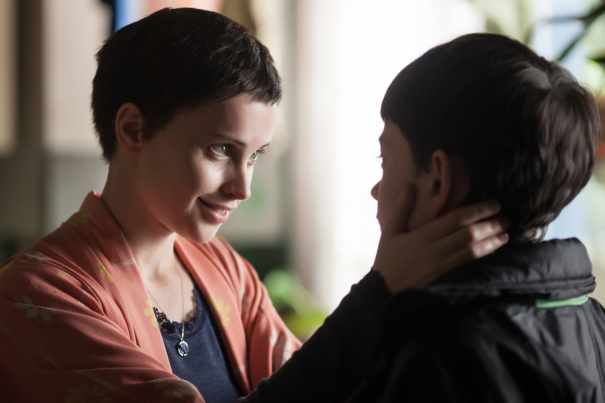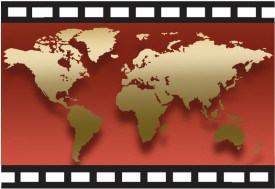
When Felicity Jones walked into the bar at the Bel Air Hotel towards the end of October, the meerkat-like LA glitterati didn’t crane their necks with the expected urgency usually reserved for movie stars whose names grace every other billboard across town, as Jones’s did that particular week.
She had come to Hollywood for the launch of Inferno, the third Ron Howard adaptation of Dan Brown’s ever-expanding Robert Langdon series starring Tom Hanks, and few can have missed the marketing blitz for Rogue One: A Star Wars Story, that has been heating up ever since last year’s Force Awakens release. Then there’s J.A. Bayona’s A Monster Calls, releasing Dec 23 after a festival rollout that has resulted in nothing short of effusive praise for Jones’s turn as a cancer-stricken young mother desperate to ensure her son is going to be OK when she’s gone.
But despite this plethora of work, with its varied appeal to all tastes, there’s something unassuming about Jones as she sats down for a drink to discuss this moment she’s having. For the stratospheric rise she’s had this past decade, Jones is still approachable; still very much real. It wrong-foots the Bel Air set, but it’s also her secret weapon: she can play a suburban mom, a scrappy rebel warrior and an ER doctor obsessed with historical puzzles, and it never feels inauthentic.
It might be because Jones hasn’t been changed by her sharp ascendance. When I met her 8 years ago, to discuss one of her earliest feature film roles in the Daniel Craig-starring Flashbacks of a Fool, she was the same curious, optimistic actress she is today. The trappings of stardom—premieres, parties and fame—don’t interest her nearly as much as getting under the skin of a wholly realized character, whatever the circumstances.
In A Monster Calls you play a young mother in the grips of cancer, trying desperately to be there for her son. What struck you about it to begin with?
Initially it was reading Patrick [Ness]’s book when I was on holiday with a few friends, and I was absolutely overwhelmed. We were all in sunbathing loungers and I had to go take a swim in the sea because I was uncontrollable.
The book taps into the reality of the experience, because Siobhan Dowd, who started the book, was suffering from cancer at the time. She actually died and Patrick Ness carried the book on for her. That’s why I feel it’s so powerful, because it is rooted in the absolute authenticity of that experience of being a cancer sufferer with children, and what it’s like to go through that.
Focus Features
It’s very specially crafted, because it’s all through the eyes of Conor and it’s his perspective; a child’s perspective on something psychologically very, very complicated. There’s a wonderful duality in that. It’s just one of the… It doesn’t happen very often just to read or go and see a film where you’re completely overwhelmed by emotion, and it’s really, bloody important to feel moved because I think that’s how we become better people.
For my character, Lizzie, it’s that end moment: her being able to actually confront it. The whole time she has a teenage spirit. She just doesn’t want to think about it. It’s annoying, she wants to get on and she wants to stay alive with her son. The moment it suddenly shifts is at the end when she has to trust her upbringing of him, and trust everything she’s given to him, that he will be okay on his own.
It was very emotional, making it. There’s nothing fake about it. There’s nothing trying to manipulate the audience. It comes from something quite deep and profound.
Where do you begin trying to figure out a character like this?
I met with these women who had gone through it and, luckily, survived. They were just very, very open about every single aspect. Both emotionally, in how it affected their relationships and how it affected their sense of self, and in the details of how their toes feel, and having to wear special gloves, and the technical side that I would have to show in the film. I was just lucky to have such openness from those people, who took me through every single step of it. It was about charting quite specifically how someone’s physicality would change, how someone’s voice changes, the dryness that you have round your lips, and how everything becomes heavier and harder.
Focus Features
At the same time, I didn’t want to lose Lizzie in the illness, because she’s still a person who’s just trying to live. I wanted her to have edges. I wanted her to have a bit of punk. She’s still a bit of a rocker. She would have gone to concerts, and she loves music, she loves art, she sees herself as an artist. Financially, she’s had a child, she’s a single parent, and so she’s had to get a job. It was equally important to make her a bit angry as well, because she’s really pissed off about what’s happening. All of those things are true to human experience, so she’s not just some soppy martyr.
How essential is it for you to put all those building blocks into place for a character?
Hugely. You know there’s always this idea that women are really good at multitasking? I definitely buck that trend, because I’m hopeless at multitasking and I really don’t like it; I love really singular, really focused tasks. And so, when you’re preparing for a part, that’s the greatest thing about it; this absolute laser focus for however long you’ve got before you start shooting to build the idea of the character. It’s a bit like being Sherlock Holmes and finding all these clues; what does it mean, why is my character wearing that watch, they’ve done that, they’ve put their hair like that, what does that say about them? You’re trying to find all these microscopic details that you then bring together, then to try and let go a little bit when you’re on set because you’ve done all that homework before.
Finding what it is that the person does physically, how they move, how they walk, what is the voice, how high or low should it be, what tone—I try to build as much of those specifics as possible. But it really comes down to a fascination with human beings and why they behave the way they behave.
Focus Features
You’re also very much at the mercy of an editor, so you’re often giving different readings of something, and different tones and looks, and you’re not always doing the same thing in every take. There’s a great sort of letting-go that has to happen so that you trust in the editing process; that the needs of the story will then take over.
That’s got to be moderately terrifying at times, hasn’t it?
It is, yeah. Suddenly your hippy spirit has to come through—that kind of ’70s mentality, where you trust the people that you make the decision to work with in the first place, and trust the story and the need to tell it.
Did you get to spend much time with Lewis MacDougall, who plays Conor, before the shoot?
I did. We would go on these group family outings with Sigourney [Weaver] and Lewis and I. We would go and see Guardians of the Galaxy and eat popcorn. Then Bayona would be watching us in the corner, making notes and things like that. We went to the zoo and we went on a rollercoaster ride, which was good because it helped prepare us for the actual fear of being on a rollercoaster ride in Blackpool at 5 a.m. in the morning when we were actually shooting the theme park scene.
Focus Features
Bayona was great at keeping the process informal. He would give me a selfie stick to, as Lizzie, film the family outing. He was always trying to find informality, and he’s always trying to break that fourth wall, so he plays a lot of music when you’re on set. It becomes impossible to retain any emotional distance. There were always tears throughout the whole experience. I’ve never seen so many people crying from start to finish.
Was she a hard character to shake off at the end of a day?
At the time I was doing a lot of promotion for The Theory of Everything, so I would be quickly on a plane and then on the other side of the world putting on a nice dress. It was a little bit more schizophrenic. It was a juggle. But I just felt very safe, actually, in that environment. I felt like I could let my British reserve go a little bit and find something a bit more vulnerable.
Your career has been marked by exciting collaborations with directors like James Marsh and Drake Doremus, and you’ve been able to find a real variety of characters to play. Has that been luck or design?
It’s interesting. I think you sometimes have to take a bit of a gamble, in that everything about the project may not be perfect when it comes through to you, but you take a punt on a director, ultimately, and on the character. Actually, you’re always building something. A lot of what you build comes from those relationships, from those dynamics, from those rehearsals.
Focus Features
Sometimes you’d have to do something because you need to pay the rent, and that’s happened. Then sometimes you’re in a position where you can be a little bit more strategic and you can go, “Actually, what do I feel about the story?” That’s become increasingly more important in the sense of, what is the storytelling? What are we saying? That’s what ultimately, really, I find really exciting about film, is that when it’s at its best it really can change things in some way.
What are you looking for in directors?
I’ve heard directing talked about as being a benign dictatorship, and I think that’s probably the best way a director should be. They’re open to collaboration and feedback from people, but ultimately it’s got to be that one person’s vision. That’s what I think makes a film really stand out. The atmosphere really changes from set to set, and it’s all about that person. It’s so important, as an actor, to watch everything a director has made, because it’ll…

